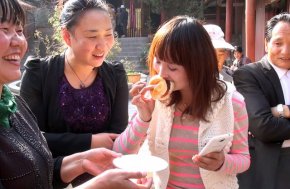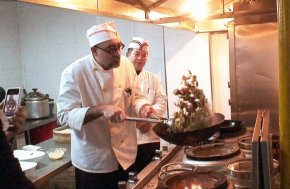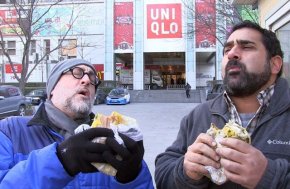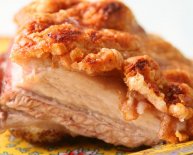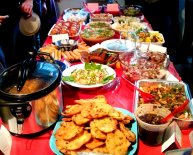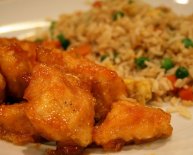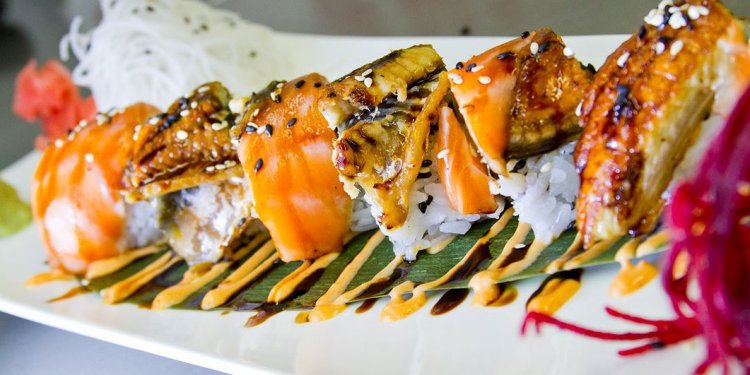
Chinese Unique Cuisine
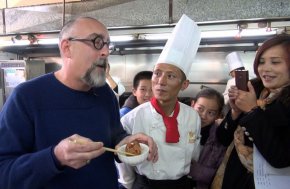 April 21st, 2016 by Eric Fish
April 21st, 2016 by Eric Fish
- Howie Southworth slurps pork trotters with Chef Yang Jiaquan at the Qianhe Hotel in Qilin, Yunnan, China. (Howie Southworth)
- Chowder in a bread bowl from "Sauced in Translation" episode 2 in Harbin, Heilongjiang, China. (Howie Southworth)
- Howie Southworth sharing a luau on Bo’ao Beach in "Sauced in Translation" episode 4 in Hainan, China. (Howie Southworth)
- Stewed Xuanwei ham with potato blossoms from "Sauced in Translation" episode 3 in Qilin, Yunnan, China. (Howie Southworth)
- A temple patron eats a veggie burger in "Sauced in Translation" episode 8 in Qujing, Yunnan, China. (Howie Southworth)
- Crayfish on the menu Zaizai Crayfish Restaurant in Beijing. (Howie Southworth)
- Howie Southworth cooks up jambalaya for the staff at the Lao Shanghao restaurant in Harbin, Heilongjiang, China. (Howie Southworth)
- Howie Southworth and Greg Matza eat jianbing in Beijing. (Howie Southworth)
After living in China in the late 1990s and repeatedly returning to visit, American Howie Southworth felt his stories and photos still weren’t quite getting across “the essence” of China to friends and family back home. He also noticed that his Chinese friends were often curious about what he ate in the U.S. So to kill two birds with one stone, he started the web series Sauced in Translation in order to give both sides a window into the other through the most basic tool of cross-cultural communication: food.
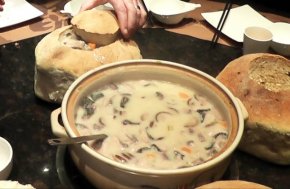 For the series, he and his friend Greg Matza travel to a different Chinese city for each episode and try the local cuisine. But the twist comes when Southworth, a classically trained cook, attempts to make an American-style meal for a Chinese crowd using only local ingredients. This has led him to taking over restaurant kitchens, a college cafeteria, and even a street-side food stand.
For the series, he and his friend Greg Matza travel to a different Chinese city for each episode and try the local cuisine. But the twist comes when Southworth, a classically trained cook, attempts to make an American-style meal for a Chinese crowd using only local ingredients. This has led him to taking over restaurant kitchens, a college cafeteria, and even a street-side food stand.
Asia Blog about what “American food” is to China and how locals respond when he enters their kitchens and alters their perceptions.
What does “American food” mean to most Chinese?
Most Chinese don’t have a clear definition of American food, per se. Throughout China you’ll see McDonald’s, Pizza Hut, and KFC, and we assumed people recognized those as American brands. In some cases, particularly among the educated and the young, that may be true, but we've asked hundreds of people on the street if they've eaten American food and they most often say no. Then we mention the fast food chains and they occasionally reconsider their answer.
There's a fundamental difference in the way that Americans view international cuisines compared to Chinese. Americans live in a country built on immigration, so we tend to categorize by region, country, if not specialty when it comes to dining. “Let's go grab some sushi, ” or “hey, you up for Ethiopian tonight?” Chinese, on the other hand, have a very long history of isolationism, and they're much more likely to see food as binary. It’s either Chinese — and that can be very rich and varied — or "other." So, the fast food joints fall into what I think is the "other" category.
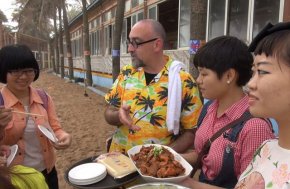 For those who do make the connection to these ubiquitous fast food chains, what kind of impression does that tend to leave about “American food?”
For those who do make the connection to these ubiquitous fast food chains, what kind of impression does that tend to leave about “American food?”
Sure, the hamburger at McDonald’s is the hamburger at McDonald’s and that is American, but overall it’s not an exceedingly accurate impression. Despite being American brands with familiar logos, even Americans may not recognize some the food that comes out of these kitchens as American. Some McDonald’s have spring rolls, KFC serves warm soy milk during breakfast, and Pizza Hut serves noodle soup.
In fact, the Chinese Pizza Hut menu is encyclopedic and includes some real gems. Recently they added durian pizza to their menu. For those not familiar, durian is a spiky fruit with a strange meaty texture and rather putrid odor. It’s horrible. Granted, durian has its place and it's very popular in Southeast Asia. Whether Chinese people believe this to be American, I can't speak to. I sincerely hope not. When durian becomes a topping, pizza ceases to be pizza.
Howie Southworth cooks chili on the street in "Sauced in Translation" episode 1 in Chengdu, Sichuan, China. (Howie Southworth)
On Sauced in Translation, what have been some of the dishes you’ve made for Chinese locals that went over especially well?
The biggest hit was chowder in a bread bowl that I cooked in Harbin in far Northeastern China. That was amazing — local buttery river fish, fresh cream from a countryside dairy, these huge sourdough loaves hot out of a bakery that was built by Russians a hundred years ago. Sourdough in China? Mind=Blown. The reason the chowder was so popular was that it was essentially a reformatted version of things locals already enjoy. One of the main missions of Sauced in Translation is to do exactly that: Serve what locals love, surprisingly reshaped into an American dish.
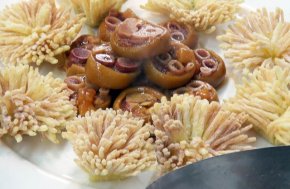 A very close second was the spicy chili in Chengdu — that was a triple, if not a home run. It almost goes without saying. Beef, soybeans, tomatoes, chilies, and beer. Nobody goes wrong with that roster in Sichuan province. How these ingredients came together may have been unfamiliar, but the flavors and what they evoked very much matched the local palate. Indeed, one woman came to a dead stop on her bike in front of where I was cooking and exclaimed, “That Chinese food smells great!”
A very close second was the spicy chili in Chengdu — that was a triple, if not a home run. It almost goes without saying. Beef, soybeans, tomatoes, chilies, and beer. Nobody goes wrong with that roster in Sichuan province. How these ingredients came together may have been unfamiliar, but the flavors and what they evoked very much matched the local palate. Indeed, one woman came to a dead stop on her bike in front of where I was cooking and exclaimed, “That Chinese food smells great!”
It may well be a cool adventure for the locals to eat the food that I cook, but it's also a remarkable experience for Greg and me. We’re not out to prove anything, necessarily, but we are, almost by accident, discovering that there are a lot more similarities between American and Chinese cuisines than most people appreciate. I think the series highlights this well.
Any culinary disasters you’ve thrust upon locals?
Any missteps on Sauced usually involve a comedy of errors. My failures are less about how a dish is received and more about being faced with an unfamiliar location, strange ingredients, or I’ll admit, chemistry. In episode six of Sauced, I cooked in a college cafeteria on Hainan Island. Eggplant parmesan was an inspired idea, but trying to make mozzarella out of ultra-pasteurized Chinese milk turned out to be a disaster. I won’t give away the ending, but let’s just say that I ended up inventing a new American dish.
I’ve also come close to disasters, but got lucky in the end. In episode 8 of the series, which is now in post-production, I make veggie burgers. I wed myself to the concept after discovering the amazing wild mushrooms in deep southwestern Yunnan province, but buns became a problem. I must have eaten hundreds of breads off camera before I found something eerily similar to slider buns, very atypical for China. That was a close one.
What’s the most unique Chinese food you’ve encountered in your travels?
Where does one begin? We had this amazing meal, also in Yunnan province. We asked this well-renowned chef for a survey of local cuisine, and he did not disappoint. This guy was the mad genius of foraging, but his prize was moss. He brought to the table a small covered bowl of soup for each of us. When we removed the lid, what appeared was a huge lump of tree moss floating in chicken broth. But, what we guessed was a mass of moss was actually a moss covered meatball. I may actually be the first American to have used that exact phrase. It was delicious, extremely local, and a revelation. Luckily, the cameras were rolling, so we caught that dish on film to share with our viewers.
